Yellowstone National Park
Updated: August 18, 2020
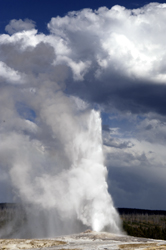
Yellowstone National Park has an official Junior Ranger Program open to children ages 5 - 12. The goal of the program is to introduce children to the natural wonders of Yellowstone and their role in preserving them for the future.
Yellowstone Park, located in southcentral Montana, northeastern Idaho, and northern Wyoming, is a spectacular mountain-locked region. The Park is surrounded by the Absaroka, Teton, Gallatin, Beartooth, and Snowy mountain ranges. The 3,472 square -mile park (larger than Rhode Island and Delaware combined) is essentially an elevated plateau with an average elevation of 7,500 feet above sea level. Three million visitors visit the park annually to marvel at the natural beauty of the Rocky Mountains and the thousands of steaming geysers, shimmering thermal pools, and bubbling mudpots. Ninety-nine percent of the park remains undeveloped providing habitat for the largest concentration of free roaming wildlife in the lower 48 states. Other spectacular features of the park include; Yellowstone Lake, over 136 square miles of surface and 130 feet deep; fossil forests; and the impressive Grand Canyon of the Yellowstone.
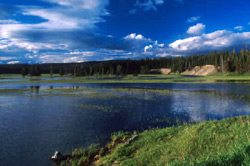
The world's first and oldest national park was established by Congress and signed in-to law by Ulysses S. Grant on March 1, 1872. Yellowstone National Park was "dedicated and set apart as a public park… for the benefit and enjoyment of all people" and "for the preservation, from injury or spoliation, of all timber, mineral deposits, natural curiosities, or wonders… and their retention in their natural condition."
Hidden underground may be the biggest wonder of all powerful volcanic, tectonic, and hydrothermal forces continually reshaping the landscape of the park. Scientists have traced Yellowstone's origin to a "hot spot" in the earth's mantle, one of a few dozen on the planet. Molten rock is only several thousand feet below the surface in Yellowstone. Molten magma so close to the surface results in geothermal and volcanic activity.
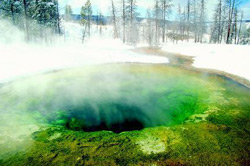
The world's largest and most varied concentration of geothermal features is located in Yellowstone-- hot springs, steam vents, mud pots and about 250 geysers. Geothermal activity results when surface water seeps down to meet the heat of the earth's molten rock. Volcanoes have erupted in Yellowstone almost every 16,000 years. Should we be worried about another volcanic eruption soon? Scientists at the U. S. Geological Survey say that while small earthquakes are common and larger earthquakes are possible every few decades, that "there is no indication that an eruption is imminent."
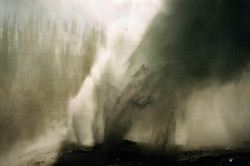
The record of early human history in Yellowstone is found in ancient artifacts left by the native Americans. An 11,000-year-old projectile found near the park headquarters indicates prehistoric hunters probably hunted in the area. Other stone artifacts and campsites show humans have lived in the area for most of the time since the last Ice Age. Small tribes of nomadic people called "Foragers" traveled throughout the region around 4000bc, and more recently "Late Hunters" roamed the area. Yellowstone was not the original homeland of any Indian tribe.
Nevertheless, one band of Shoshone called the "Sheepeaters" did live in the Park for a time. The Sheepeaters hunted bighorn sheep, an essential part of their diet, in the rugged park area. They remained in the park until 1871, when they joined their kinsmen on the Shoshone Wind River Reservation.
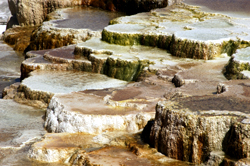
The written history of the park dates back to the 1805 - 1806 journals of Lewis and Clark. William Clark notes Indian accounts of the region, "There is frequently heard a loud noise like thunder, which makes the earth tremble, [Indians] state that they seldom go there because [their] children cannot sleep and conceive it possessed of spirits, who were adverse that men should not be near them." Explorers Lewis and Clark did not venture into the area during their expedition across the West. Although the details are a little sketchy, John Colter is accredited as the first white man to enter Yellowstone Park country. Colter, a member of the Lewis and Clark party, is presumed to have explored the area when Lewis and Clark returned to St. Louis, Missouri. He spent a full winter, probably 1807 - 1808, trapping and wandering through what is now the park. Although it's impossible to fix Colters exact route, historians believe that he went up the Yellowstone River to find "Colter's Hell" and returned by way of the Clark Fork River. Three years later, he reported his discoveries in St. Louis. His stories of the region were mocked and called mad hallucinations.
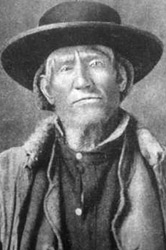
Several other trappers followed Bridger into the Yellowstone between the years of 1829 and 1860, including Joe Meek, Jim Bridger, Warren Angus Ferris, and Osborne Russell. Their fantastic stories of "fire and brimstone" were often met with disbelief. Furthermore, recounting doubtful tales of wonder became a mountain man's game, a form of pure entertainment far removed from the serious matters of their daily lives.
After the Civil War, people again turned their attention to the Western Frontier. The search for gold drew men into the area in the 1860s. Probably a dozen groups of miners had some contact with the area, but none could reliably confirm the existence of the natural wonders. Called lies or delusions of drink, the miners' tales nevertheless fanned curiosity in the local saloons.
After years of rumors and speculation about Yellowstone Country, a party of reputable men decided it was high time to check it out. In 1869, David Folsom, C.W. Cook, and William Peterson left Diamond City, Missouri, to explore the area. They noted that they had seen landscapes "surpassing in grandeur" anything they had ever seen. After returning, Folsom first discussed the idea of preserving Yellowstone from development so that all Americans could have the opportunity to gaze on and enjoy its wonders.
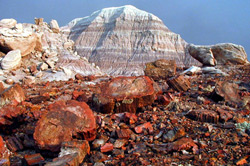
The most famous of the 1870 parties to explore the Yellowstone area was led by Henry D. Washburn. This party is often credited with "discovering" the park. The expedition named many of Yellowstone's landmarks, including Mount Washburn and Old Faithful. After the expedition returned, the story of their journey made headlines across the country. Including the account of a party member, Truman C. Everts who became hopelessly lost for 37 days as winter approached.
Upon hearing the account of Langford's expedition, Ferdinand V. Hayden, the head of the U. S. Geological Survey, was appointed by Congress to make an official exploration into the region. The party was stunned by the wonders and beauty they saw, Hayden made a 500-page report to Congress, and lobbying to make Yellowstone a national park began. On March 1, 1872, President Ulysses Grant signed into existence the world's first national park.
Since its creation, Yellowstone National Park has been the target for opportunists and exploitation. In 1886, the military took jurisdiction over the park to prevent vandalism and poaching. Later in 1894, the Lacy Act was passed to protect park wildlife (except for coyotes and wolves).
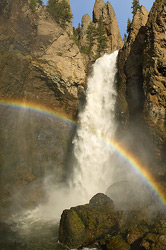
The park's Grand Loop (the main roadway through the Yellowstone) was proposed in 1886. By 1903, the railroads had reached the park and were bringing visitors by the carload. The Park's grand lodges and hotels were built in the years 1890 to 1904. In 1915, the first automobile passed through the park's gates - a Model T Ford, opening up the age of the automobile. Only two years after the first car entered Yellowstone, some 5,000 entered during the summer season of 1917. On March 1, 1997, Yellowstone Park celebrated it's125th anniversary and welcomed over 3 million visitors.
Today the park offers a variety of lodging and camping opportunities, from the majestic Old Faithful Inn to backcountry camping, and a wide range of activities for the visitor including backpacking, bicycling, boating, fishing, horseback riding, wildlife watching, hiking, photography and guided tours in the summer, and ice skating, cross-country skiing, snowshoeing, snowmobiling, and guided snow coach tours in the winter.
Kids can become Junior Rangers by dropping in at any visitor center and picking up a copy of the Junior Ranger Newspaper. Also for kids are self-guided audio tours and interpretive trails. We hope to see you soon in Yellowstone Park! Must-see attractions in the park are Mammoth Hot Springs, Tower Falls, Petrified Forests, the Grand Canyon of the Yellowstone, Old Faithful Geyser, Grand Prismatic Spring, Morning Glory Pool, Yellowstone Lake, and the West Thumb Geyser Basin.
Updated: August 18, 2020

